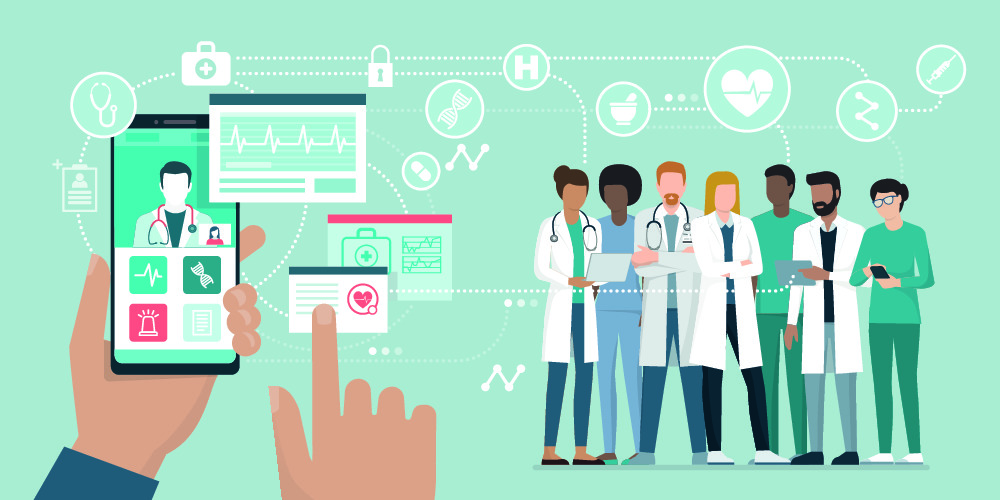-The 1st COSMO Innovation Seminar-
COVID-19 is prompting an acceleration in digital transformation across all sectors. In the healthcare sector, there is growing anticipation for online medical care, app-based treatments, and “digital health”, or health management using digital devices. Regulation prohibiting physicians from providing online medical examinations to first-time patients was lifted in April this year. This was followed in July by the government announcing its Honebuto Plan, in which it stated that it would “develop a scheme to enable patients to receive the entire medical care process online, from medical examinations to receipt of pharmaceutical drugs, by offering electronic prescriptions, online medication guidance, and delivery of pharmaceutical drugs.” This trend of digitalization is only expected to accelerate further.
In recognition of this, COSMO Healthcare held the 1st COSMO Innovation Seminar on October 30 to further public understanding of digital health. Specialists knowledgeable of the current status and future of digital health in Japan and abroad were invited to join lectures, a speaker panel discussion, and participant Q&A session.
The following report includes an overview of the seminar with selected transcripts. (Please note that Japanese honorifics have been omitted for ease of reading).
A video recording of the seminar (Japanese language only) is available to view on Cosmo Healthcare’s official YouTube channel.
The 1st COSMO Innovation Seminar

Lecture 1
Current Issues and Future Prospects for Telemedicine and Digital Health in Japan
Hiroaki Kato, Visiting Professor at Digital Hollywood

■ Current Situation
First, let me talk briefly about the current status of online medical care, which has been attracting a lot of attention recently. Telemedicine or online medical care refers to “physicians offering patients medical care using telecommunications devices in a real-time manner, including medical examinations, conveying diagnosis results, and providing prescriptions.”
Patients can communicate with physicians over the phone and receive prescriptions online. In the past, this form of medical care was for patients continuing treatment for symptoms that have subdued after hospitalization. However, due to the impact of COVID-19, it has now been made available to all patients, including first-time patients, and phone-only care.
Governed by the “Policies Regarding the Provision of Online Medical Care”, online medical care can be largely divided into self-funded and insurance-covered medical care. As for insurance-covered care, medical service fees covered by insurance are revised once every two years. There is also the fully self-funded remote consultation services for health and medical care that are not categorized as medical practices. Thus, there are three levels to physicians providing care to patients online. Remote consultation services for health and medical care offer consultations based on manuals and are provided through online chats or video calls.
To give you a brief history of online medical care in Japan, telemedicine began in August 2015 with phone services for return-visit patients of any types of diseases. However, new policies on online medical care announced in March 2018 and the following revision in medical service fees in April of the same year restricted diseases eligible for online medical care. This year, online medical care was once again permitted for all diseases for both first-time and return visits, as part of special measures amid COVID-19.
■ Digital Health Trends: Understanding the Basics
Regulatory Reform
Data from the Ministry of Health, Labour and Welfare shows that after the special COVID-19 measures permitted online medical care for first-time visits, the number of phone-based medical care cases for first visits reached 5,300 in April; 9,700 in May; and 5,700 in June. About 60% were phone-based and 20-30% were online.
The move toward reforming online medical care regulations saw discussions held on October 8 by Norihisa Tamura, Minister of Health, Labour and Welfare, Taro Kono, Minister for Administrative Reform, and Takuya Hirai, Minister of Information Technology, during which they agreed to lift the ban on online medical care for first visits as a general rule, accelerating the drive to make online medical care a permanent system, as ultimately declared by Prime Minister Suga on October 26.
However, the Japan Medical Association is emphasizing the importance of safety and trust and requesting the service to be narrowed down to primary physicians, as well as prohibiting new patients that physicians have never treated or have not received medical information from. The Hodanren and Japan Hospital Association have also expressed opposition toward making online medical care a permanent service, while the Japan Primary Care Association has highlighted risks associated with providing the service to first-time patients. As such, there continue to be many heated discussions on the issue. The Minister of Health, Labour and Welfare has stated that he plans to set out a clear direction by the end of the year. It is predicted that primary physicians will be a key condition for first-time patients.
 Personal Health Records (PHR)
Personal Health Records (PHR)
Personal Health Records (PHR) are records of one’s health-related information, including regular and special health examination results (blood and urine test results, chest X-ray, etc.), blood pressure, pulse, weight, number of steps taken per day, medical records at hospitals, medical images, prescription information, and surgery history. It enables patients to manage and leverage their own health, medical care, and nursing care-related information in order to receive optimal services for their health condition.
It is thought that managing one’s health-related information through PHR will also prompt patients to proactively enhance their health, change health-related behaviors, and consult with medical institutions when necessary. This will significantly change in March 2021, when the online certification confirmation will be implemented and information from special medical examinations will be linked to the Mynaportal and associated My Number card information. According to the Minister of Health, Labour and Welfare’s digital health reform plans, in addition to information from special medical examinations, linked information will include prescription information indicated on health insurance claims from October 2021, as well as a history of surgeries, dialysis, and medical institutions visited, information on applicability, and electronic prescriptions from 2022. This will see data managed at a national level linked to an API, enabling information to be viewed across regular apps.
Medical institutions nationwide will be able to confirm medical information, while individuals will also be able to check their own health-related information at any time. For example, in September this year, an Apple Watch app was launched that includes electro-cardiogram functions and other functions that notify users of pulse irregularities. It is expected that that these kinds of touchpoints between daily life and medical care will increase.
Medical AI
In April 2018, the US Food and Drug Administration (FDA) approved a device that diagnoses images without the judgement of physicians, marking the first approval of its kind for AI software. In Japan, nine AI-based medical devices have been approved since December 2018, including those that detect lesions in the colon, discern pulmonary nodules with chest CTs, support lung cancer diagnoses, and detect COVID-19-related lesions with chest CTs. Proposals by the Cabinet Office put forward an “AI hospital” concept that leverages AI for a range of processes, from medical examinations to treatment and outpatient visits, as well as interview-based medical examination support, image diagnosis, treatment policy planning support, surgery support, or nursing support.
■ How Japanese Medical Care will Change in the Lead up to 2030
Outside of Japan, the world’s online medical care will mainly focus on homecare. Just as people have blood pressure measurement devices and bodyweight scales in their homes, they will have otoscopes or stethoscopes sets, which they will use to provide data to physicians during online medical care. Online medical care will therefore be provided not just by interacting virtually, but also by sharing data, eventually becoming an Internet of Medical Devices (IoMD).
Unmanned clinics without physicians on-site are already operating in China, where medical care is provided using a combination of AI diagnostics, remote diagnoses, remote prescription guidance, and online sales of prescription drugs. There is growing potential for its use in places with few physicians such as depopulated regions.
In the past, medical care started when patients visited hospitals, but now, medical care covers prevention, health exams, post-treatment health management, and rehabilitation. The widespread adoption of online and at-home medical care will see touchpoints with medical care extend beyond hospitals and increase throughout society and everyday life.
Japan has stated its intent to enable easy medical testing and treatment at home by 2040, and R&D efforts to achieve this goal are underway. However, technology advances exponentially, so speaking as a clinical physician, I believe that even by about 2030 only those who truly need to visit hospitals will be doing so. For example, those needing real-time procedures like surgery or treatments that require professional management will still need to visit hospitals, but others will be able to receive treatment online from the outset .
Lecture 2
Global Digital Health Initiatives Expected in Response to COVID-19
Miyako Yoshizawa, Senior Associate, Coral Capital

■ Changes to US Healthcare Startup Investment Due to COVID-19
Total investment in digital health startups in the US peaked in 2018 at 8.2 billion USD and declined in 2019. However, it is projected to hit a record high of 9.4 billion USD in Q3 2020, or 12 billion USD annually due to the impact of COVID-19. Looking at total investment up to Q3, the three areas that received the most funding were: 1) online fitness (1.26 billion USD); 2) research and development support (1.302 billion USD); and 3) online practices and related areas (2 billion USD).

■ Three Startup Areas in the Spotlight
1. Online Fitness
Whether it’s selling home fitness devices, offering real-time, online training services, offering a smart fitness system for home strength training, or offering interactive training programs, such as indoor cycling and running, these startup businesses are growing rapidly due to COVID-19. A common trend among these startups is to get users to purchase high-priced devices and equipment upfront, thereby preventing subscribers from leaving or switching to other services.
2. Research and Development Support
Life science R&D support solutions for drug discovery and clinical trials received the second-highest level of investment in 2020. Among those attracting attention and raising a lot of money are online practice and related areas; AI drug discovery startups that provide infrastructure for AI drug development; AI drug discovery biotechs that are engaged in new small molecule drug discovery; and bio-ventures.
3. Online Practice and Related Areas
As of April 2020, there were on average 65,000 online consultations per day in the US, and the total number of telemedicine consultations across the US is expected to reach more than 1 billion by 2020. Previous projections for the year 2020 have been in the range of 39-60 million online clinics, so it is easy to see how rapidly that number has grown.
To explain this, we have to look at the government’s response after early March when the number of COVID-19 cases in the US began to increase. Not only were online clinics endorsed by the government, but there was also a drive towards removing geographic restrictions (lifting the ban on consultations by cross-state clinics), and relaxing privacy and security requirements, especially for existing medical institutions. In some cases, it encouraged the initiation of online medical care in existing medical institutions, while the expansion of insurance reimbursement and waiver of co-payments for online medical care through public and private health insurance also encouraged adoption of online medical care.
The startup areas involved in online practice include online practice platforms; disease-specific chronic disease treatment programs such as diabetes, hypertension, and kidney disease; online practice vendors for existing healthcare providers; home testing kits; and prescription drug delivery. Startups that offer home testing kits also offer online practice services, either on their own or in conjunction with existing online practice companies. With the growth of online practice, ‘e-pharmacy’ prescription drug delivery is growing, and it will be interesting to see what happens to the digitalization of prescription exchanges and pharmacies as online practice grows in Japan.
■ Digital Health Post-COVID-19
COVID-19 has led to rapid changes for digital health companies in the US since March, but there is a lot of focus on how they will take root in the long term post-COVID-19. Three main issues are likely to prevail in discussions:
1) Increased platform competition – Competition will intensify as entry of disease-specific care platforms, comprehensive online medical services, and existing pharmacies going online accelerates. As platforms expand their services, we also expect to see acquisitions between companies and fairly broad vertical integration involving other companies.
2) Accelerated data use – The proliferation of digital health solutions in healthcare settings and consumers’ lives will increase the quantity and quality of data and its use.
3) Longer-term regulatory development – Although a number of startup solutions were temporarily permitted in the US, relaxed regulations and security requirements may be re-tightened after COVID-19 making these services will no longer be available, so people are keeping an eye on the long-term regulatory landscape.
Speaker panel discussion
Japan’s Accelerating Digital Health Due to COVID-19: Challenges for Government, Industry, and Investors
Facilitator: Yuki Maeda, Editor-in-Chief, AnswersNews

Mr. Maeda: Before we get into the discussion, let’s take a look at the state of digital health initiatives in the pharma industry. Over the past few years, pharma companies have also accelerated their external partnerships to embrace digital technology. As a result, what was once primarily a “pharmaceutical treatment” business has expanded to include “digital treatment”, “digital patient support”, “digital prevention”, and “digital diagnosis”.

So let me ask you both, what are the challenges and solutions for accelerating digital health in Japan, and what are the solutions?
Mr. Kato: From a business perspective, the first thing that needs to be addressed is the issue of universal health insurance that will become the bottleneck [to advancing digital health] in Japan. With 30% co-payments and an initial consultation fee of 2,000 or 3,000 yen, if we don’t have a clear idea of how much sales will be generated by the new services, it will be difficult to launch as a new business, and the service will not permeate.
Ms. Yoshizawa: The problem in Japan is that, compared to health insurers in the US, they do not see themselves as a fund. In the US, both private and public health insurance systems are available, and there is an impetus to utilizing digital health to control increasing medical costs. In contrast, I think the biggest issue is that Japanese health insurers are not using digital health to reduce the burden of medical costs, so I would like to see more progressive health insurers emerge.
Mr. Maeda: What is the monetization situation and profitability of startups like in the US?
Ms. Yoshizawa: Since medical expenses are very high in the US to begin with, it would be beneficial to the health insurance companies if they could cut back on the costs by going online. Even so, I think that the monetization of startups in the US is a strong point, as they are able to provide services at a higher price than in Japan, and health insurance pays for most of the cost.
Mr. Maeda: You mentioned health insurance, but the area of healthcare management is a service outside the scope of public medical insurance system in Japan, and I think there is a question of who will actually pay for this field. What are your thoughts on this?
Mr. Kato: Let’s say for example that a pharmaceutical company is collaborating with a gym, and if a patient has diabetes and needs exercise therapy, the doctor recommends their partner gym’s app. There are healthcare services that are unrelated to hospitals, but it is noteworthy that when certain healthcare and non-medical services are recommended by doctors, patients tend to utilize them continuously and more frequently, so this is an interesting initiative that I have been observing.

Ms. Yoshizawa: In Japan, medical care at one’s own expense is still relatively small compared to insured medical practices, but recently, with the rapid growth of cosmetic surgery, I feel that people, especially young people, are becoming less reluctant to pay the full amount of their own medical expenses. Also, I think that these days providing coaches or mentors to gym users may also be considered for mental health purposes. These types of initiatives to help users become healthier are solutions outside of healthcare, so I think that if you consolidate the budgets all into healthcare, then it will become profitable. Even fortune-telling services that are prominent in Japan are a viable market since Japanese people tend not to seek mental health services.
Mr. Maeda: The major theme of today’s discussion is online medical care. What kind of business development and expansion can be expected in the future using online medical care as a platform?
Mr. Kato: You mentioned that platform companies aren’t growing very fast in the US as well, but they won’t grow unless they have services associated with online medical care. For example, I think the market will grow more for digital equipment at home and remote medical consultations.
Ms. Yoshizawa: If clinics with strong online medical care and websites emerge in Japan, and they develop, I think they will become a platform. Another thing is that in the US, with the spread of online medical care, doctors are now able to do a variety of part-time jobs in real time, and there has been a growth in physician recruitment and on-demand employment platforms for doctors. In Japan, salaries for working doctors are not high, so I expect that expanding the range of part-time jobs, such as changing the salary structure, will help solve some of the problems facing Japanese doctors.
Participant Q&A
Q. In Japan, it seems that online medical care is met with resistance from doctors’ associations. What is the reaction of US physicians regarding online medical care?
Ms. Yoshizawa: Naturally, there is a similar concern in the US that the quality of online medical care may be lower than face-to-face treatment, but online medical care is becoming more and more popular because it gives individual doctors more places to work and more income.
Q. Will online medical care actually impact hospital management, such as creating a reluctance on the hospital’s part to [physically] see patients?
Mr. Kato: Online medical care reimbursement is lower than that of in-person, and the cost performance is worse considering that doctors would have to go through the hassle of interacting online compared to the set pattern of conventional face-to-face care. Most importantly, the average age of doctors in Japan is 50 years old, and the average age of a general practitioner is 60. They have gained trust through examining patients face to face, making online medical care hard to accept for them. Even by overcoming this mindset obstacle, the challenge remains that the more doctors switching to online medical care to prioritize patients’ health, the more will lose revenue.
Q. Is the hurdle facing home testing for online medical care a technical or a regulatory one?
Mr. Kato: In the case of medical devices, there are regulations governing its management, so at present, most of the devices are purchased at the hospital and rented out. On the other hand, we are discussing whether the devices used in the medical field can be made smaller for use at home.
Q. Are there any digital healthcare products you mentioned today that you see entering the Japanese market in the future?
Mr. Kato: I think online fitness has high potential. I think there will be also be support for clinical research. There are a lot of good services, but the question is whether people will pay for them and whether they can profit in Japan with the fee structure. Some things such as the unmanned clinics I mentioned would not be feasible in Japan due to regulations.
Q. You mentioned that you’re looking at PHRs in conjunction with the Mynaportal. What are the implications for pharma companies?
Mr. Kato: In order for a pharmaceutical company to develop services tied to a disease, I think that they will have to go through API collaboration to have their own apps view data collected on the Mynaportal, and then link it to various services. As the president of one pharmaceutical company has said, they will remove the word “pharmaceutical” from their company name. They will have no choice but to shift from a singular approach of drugs as the mainstay of their business, to one that provides a range of services focusing on the disease area.
Mr. Maeda: I think that all pharmaceutical companies have a need to utilize data from the Mynaportal. It is important to consider how to increase the number of touch points with patients, and I think that this is something that can be used.
Q. Is there a service in the US where personal healthcare data is already linked and connected in the digital health domain, such as on devices?
Ms. Yoshizawa: Often in the US you cannot use services unless you enter something like a social security number. Japan will probably offer a variety of online services, but I think that if the services are designed so that people have to enter their personal information-related numbers when they use the services, the [positive] effects of the integration will be felt by all the services.






